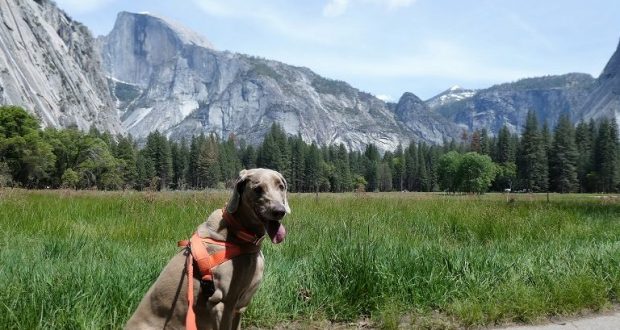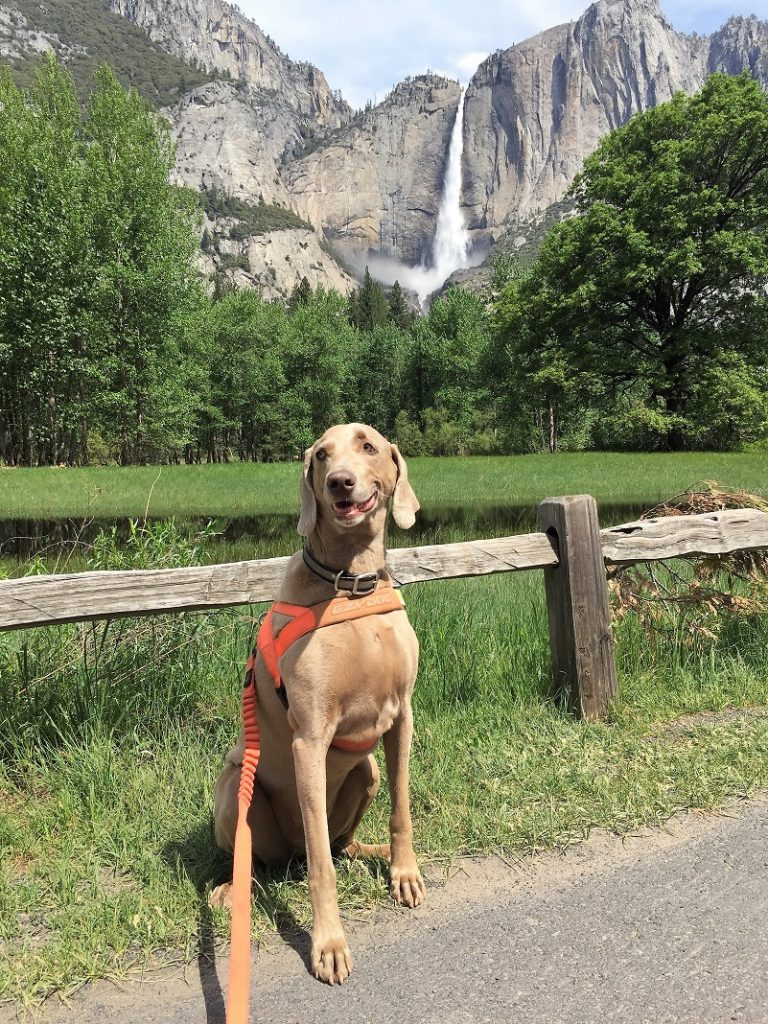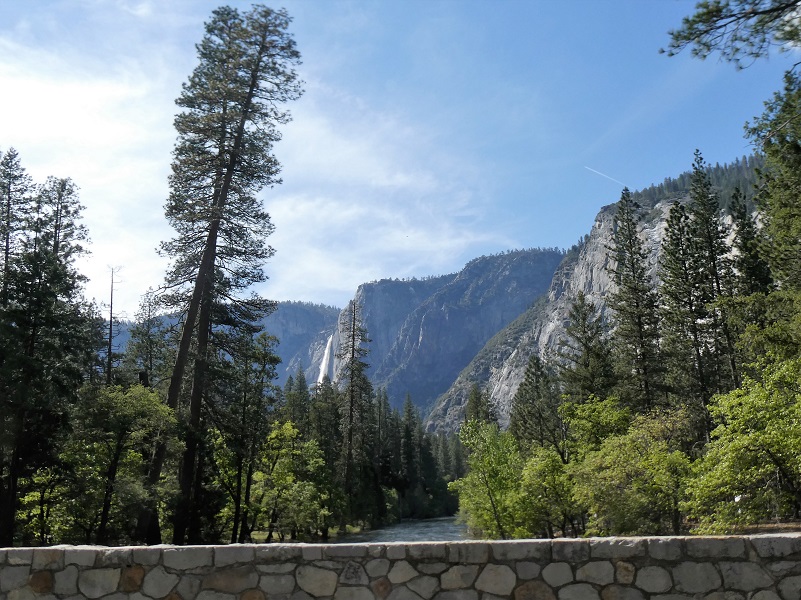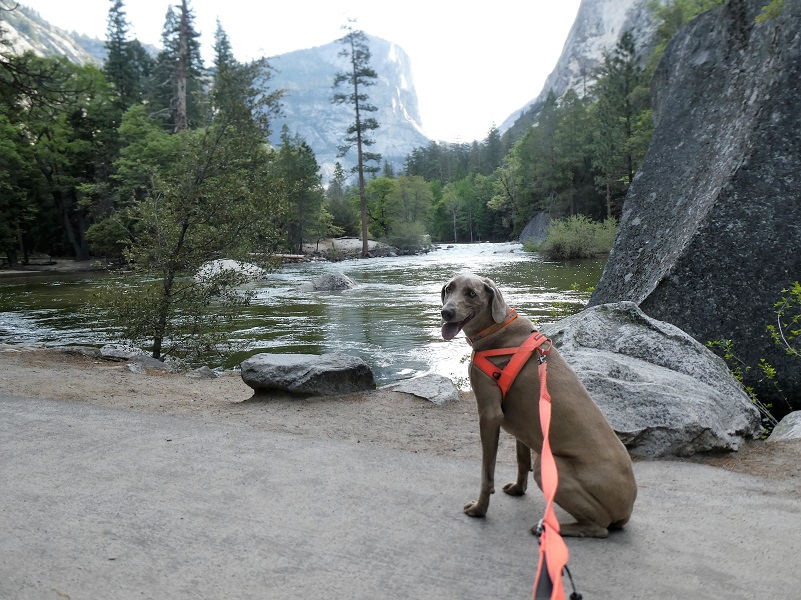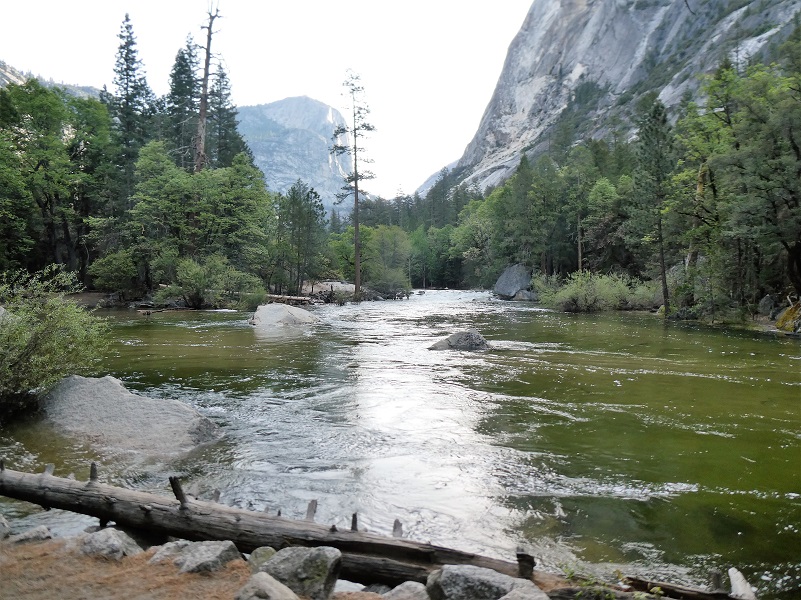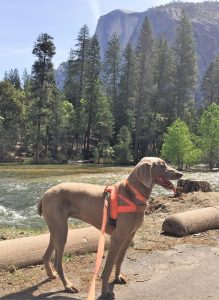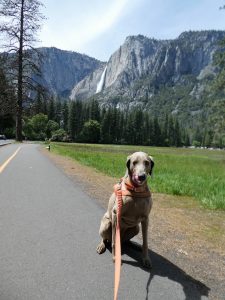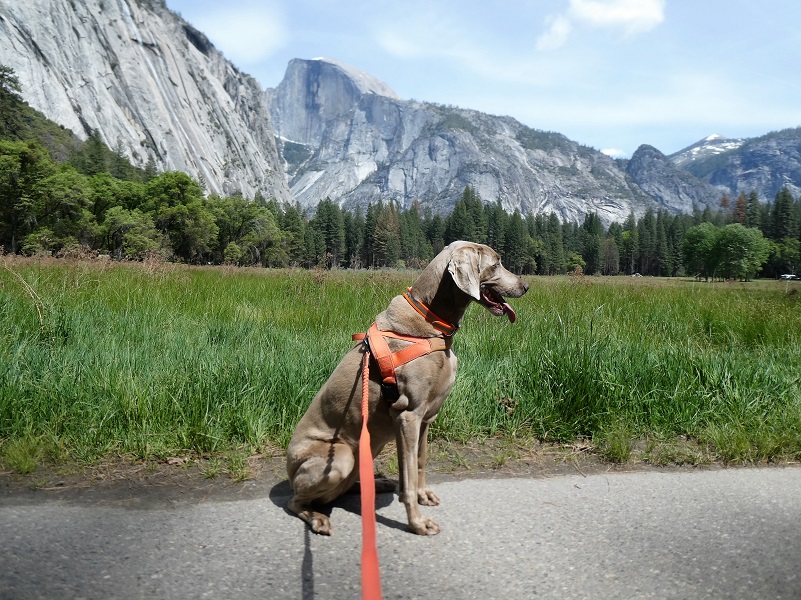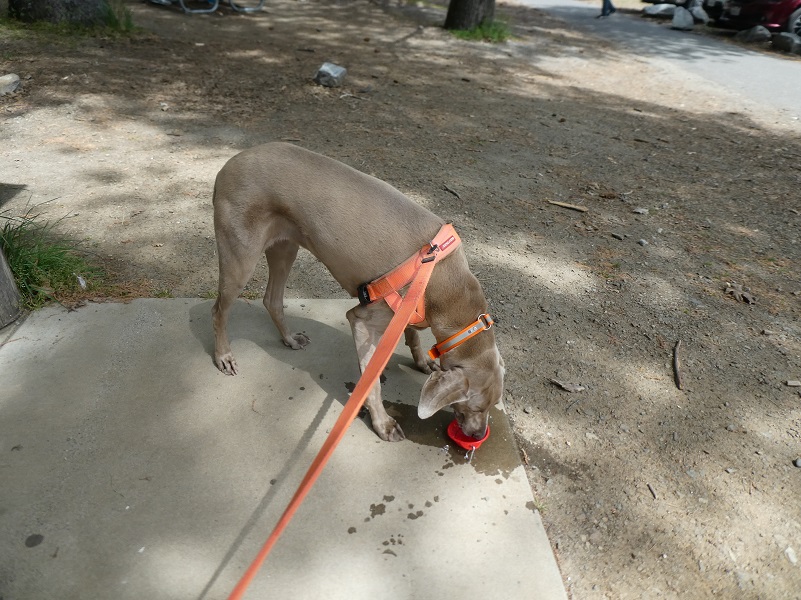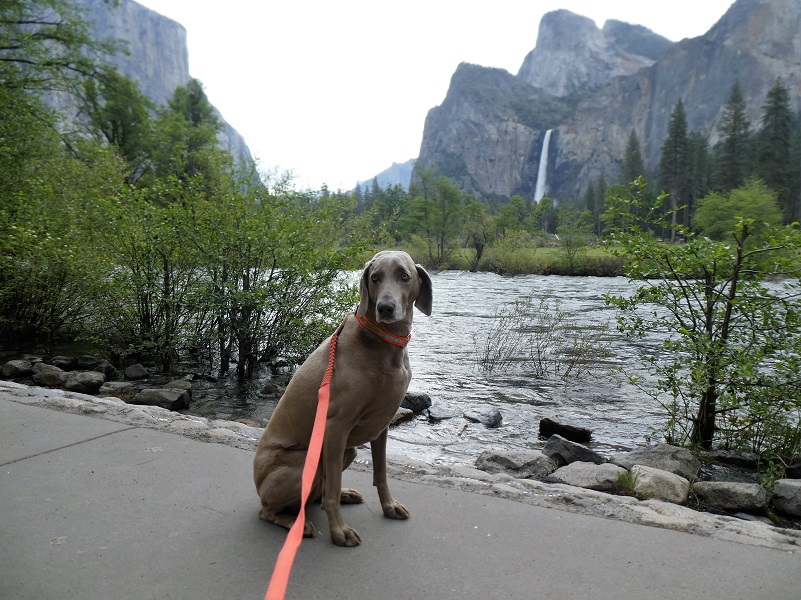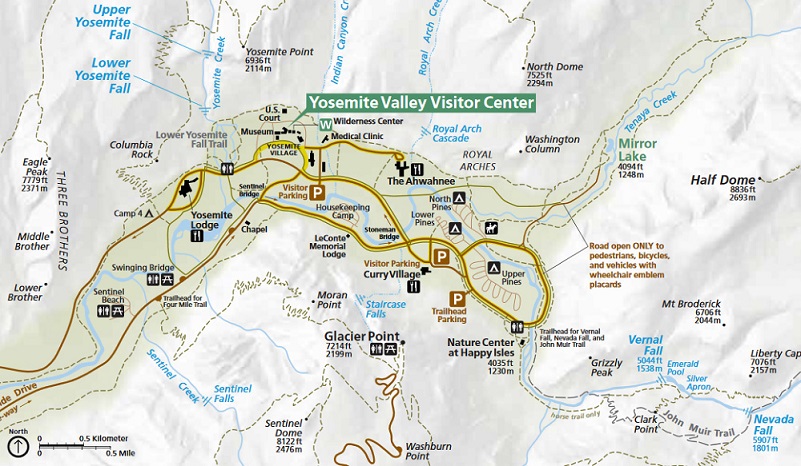My dog Sally is now a BARK Ranger and we want to share what we learned when we headed to Yosemite Valley to do some camping, checking out the dogwood blooms and exploring the trails where dogs are allowed.
Where: Yosemite National Park
Difficulty: Easy
Elevation Range: 3,888 to 4,129′
Date: May 13 – 15, 2019
Maps: El Capitan
Dog Hike? Yes
My friend Deb had spent a night camping in Yosemite Valley in order to be closer to check out the dogwood blooms and waterfalls and it got me to thinking about giving it a try. When I hike in Yosemite, I almost always post that it isn’t a dog hike, but what if I purposefully looked for dog adventures in Yosemite Valley? Could Sally and I do this? I learned that a dog that follows all of these rules is called a BARK Ranger, so do Sally and I have what it takes to earn this title? I watched the campground reservations online for cancellations for a few days until I saw one that sounds like a winner, then snagged a campsite for 4 days at the Upper Pines Campground with the intention of doing a few hikes with Sally while following all rules. So what are these rules? From Yosemite National Park:
???? Bag your waste (humans, this one’s on you)
???? Always wear a leash (no longer than six feet!)
???? Respect wildlife
???? Know where you can go…
Dogs are welcome on all bike paths and boardwalks in Yosemite Valley, as well as the Cook’s Meadow Loop and the trails to Bridalveil and Lower Yosemite Falls. Remember that they are NOT allowed on the Mist Trail or any trails in wilderness areas. Swiftwater and wild predators pose threats to both pets and their owners.
Rules regarding dogs in Yosemite National Park vary based on where you are. Yosemite Valley has more dog friendly hiking options on the valley floor but once you leave the valley, you are in Yosemite Wilderness Area which has much different rules and for the most part dogs are not allowed on the trails. I recommend you check out Yosemite Pet Rules for the latest rules and information.
If you bring your pet to Yosemite, please protect your pet, other people, and park wildlife by abiding by these regulations:
Where Pets Are Allowed
-
- In developed areas
- On fully paved roads, sidewalks, and bicycle paths (except when signed as not allowing pets)
- In all campgrounds except walk-in campgrounds (e.g., Camp 4) and in group campsites
Additionally,
-
- pets must be restrained on a leash not more than six feet long or otherwise physically restrained
- leashed pets may not be left unattended
- for the courtesy of other visitors, human companions are responsible for cleaning up and depositing pet feces in trash receptacles
- remember that pet food is also bear food: store pet food as if it were human food.
Where Pets Are Not Allowed
-
- On trails, including the trail to Vernal Fall (however, pets are allowed on the Wawona Meadow Loop)
- On unplowed roads covered in snow
- In undeveloped and wilderness areas
- In public buildings
- On shuttle buses
- In lodging areas
- In all walk-in and group campgrounds/campsites, including Camp 4
- In any other areas, as signed
These regulations protect both pets and wildlife from disease and each other. The National Park Service has prohibited pets on trails for many years. In particular, some pets chase wildlife, pollute water sources, and can become defensive and dangerous in unfamiliar surroundings. Pet owners have the burden to assure their pet does not damage the park values for others in those areas where pets are allowed.
I made sure that Sally had her 6 foot long leash and plenty of dog waste bags, along with her other camping supplies. As we drove into Yosemite Valley, I figured that since Sally hadn’t done the tourist thing in Yosemite Valley, she would want to have her picture taken at the famous landmarks and from varying angles.
We took a short walk on the boardwalk to check out Yosemite Falls a bit more.
When we checked into the Upper Pines Campground, we were briefed about proper storage of our food and water, which meant that if it wasn’t inside a hardshelled camper/RV or in the bear locker, it should not be left unattended and that included water. I usually keep a bucket of water for Sally at our campsite but we made sure that we put it in the bear box when we weren’t at the campsite and at night. Once we got settled in our campsite, we took a short walk on the road to Half Dome Village to check out the dogwoods. There were distractions but Sally was determined to get her BARK Ranger badge.
The next morning we got up early and walked on the road that followed the north side of Tenaya Creek up to Mirror Lake.
Dogwood blooms along the road were still very nice.
When Sally and I arrived at Mirror Lake, we were very surprised to discover that Tenaya Creek was running fast through the area and the “lake” was more of a river without those amazing reflections that it is known for.
At the end of the pavement at Mirror Lake, Sally discovered the sign that marked the end of the trail for dogs on this trail so we turned around and headed back along the road that followed the south side of Tenaya Creek, making a loop back to our campsite, a little over 2 total miles.
After I ate lunch and did some reading while Sally did some napping, we headed out on roads and bike paths toward Ahwahnee Meadow, between Yosemite Valley Lodge and the Magestic Yosemite (Ahwahnee) Hotel.
By the time we reached the restrooms on the north side of Ahwahnee Meadow, I thought Sally would enjoy a drink of water. I had brought water and a collapsible water bowl with me, but was able to fill her bowl up from the drinking fountain. She drank it all up . . .twice.
Well, weather cut our trip a little short with rain forecasted, so Sally and I packed it up and headed home after 2 nights of camping. I had planned on taking Sally up to Lower Yosemite Falls but it was sprinkling on my way out and I got a bit lazy. We did stop on our way out at the “Gates of the Valley” turnout for one last photo shoot.
I had originally planned on camping 4 nights but the weather forecast showed rain coming in so we headed home a little early. I think Sally enjoyed her camping trip in Yosemite Valley and did quite a few walks around the area with me. I was afraid that it would be a bit too peoply for me and had purposely planned on doing our walks early in the morning and in the evening after the main tourist rush was over, plus it would give me a chance to see the valley at a time when I am usually heading home. That strategy helped but there were still lots of people and the campground was a generator city during the hours that generators were allowed. You could set your watch by that schedule. Not everyone followed the dog rules and a couple of small dogs that were not on leash in the campground took off after Sally as I walked her on leash on the road through the campground. If there really was an actual Bark Ranger Badge, I think Sally earned it.
Dog Hike? Yes
Rules regarding dogs in Yosemite National Park vary based on where you are. I recommend you check out Yosemite Pet Rules for the latest rules and information.
If you bring your pet to Yosemite, please protect your pet, other people, and park wildlife by abiding by these regulations:
Where Pets Are Allowed
- In developed areas
- On fully paved roads, sidewalks, and bicycle paths (except when signed as not allowing pets)
- In all campgrounds except walk-in campgrounds (e.g., Camp 4) and in group campsites
Additionally,
- pets must be restrained on a leash not more than six feet long or otherwise physically restrained
- leashed pets may not be left unattended
- for the courtesy of other visitors, human companions are responsible for cleaning up and depositing pet feces in trash receptacles
- remember that pet food is also bear food: store pet food as if it were human food.
Where Pets Are Not Allowed
- On trails, including the trail to Vernal Fall (however, pets are allowed on the Wawona Meadow Loop)
- On unplowed roads covered in snow
- In undeveloped and wilderness areas
- In public buildings
- On shuttle buses
- In lodging areas
- In all walk-in and group campgrounds/campsites, including Camp 4
- In any other areas, as signed
These regulations protect both pets and wildlife from disease and each other. The National Park Service has prohibited pets on trails for many years. In particular, some pets chase wildlife, pollute water sources, and can become defensive and dangerous in unfamiliar surroundings. Pet owners have the burden to assure their pet does not damage the park values for others in those areas where pets are allowed.
Yosemite Hospitality operates a dog kennel in Yosemite Valley from approximately late May through early September. Written proof of immunizations (rabies, distemper, parvo, and Bordetella) must be provided. Dogs must be at least 20 pounds (smaller dogs may be considered if you provide a small kennel). You can get more information about the kennel by calling 209/372-8326.
Map:
Prior Blogs in the Area:
Hiking Through Dogwood Blooms at Mirror Lake April 30, 2018
Dogwoods, Waterfalls and Reflections along Yosemite’s Valley Loop May 3, 2017
Mirror Lake Loop Hike April 26, 2016
Leaf Peeping in Yosemite Valley October 23, 2014
Sources:

